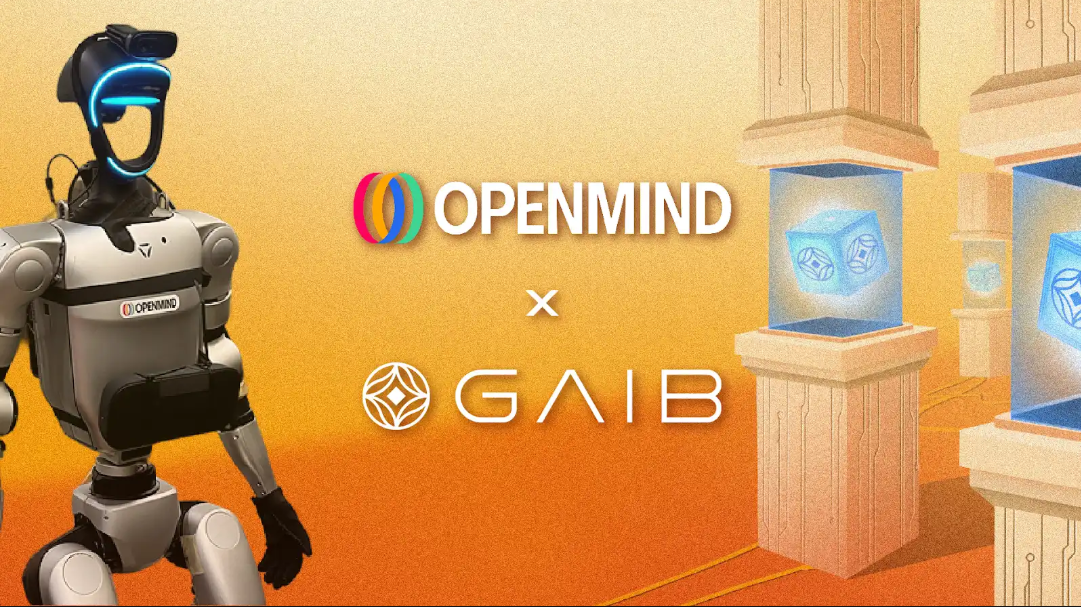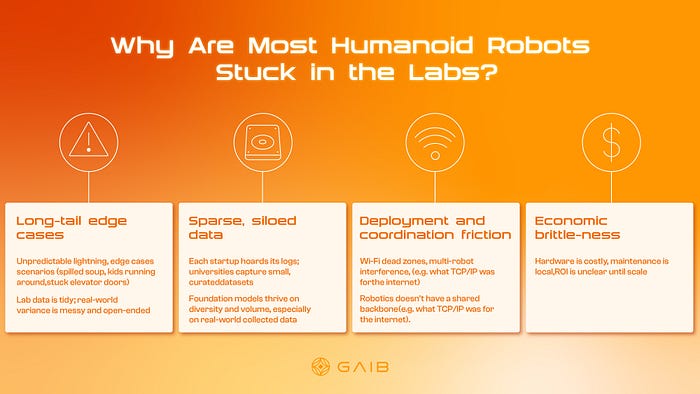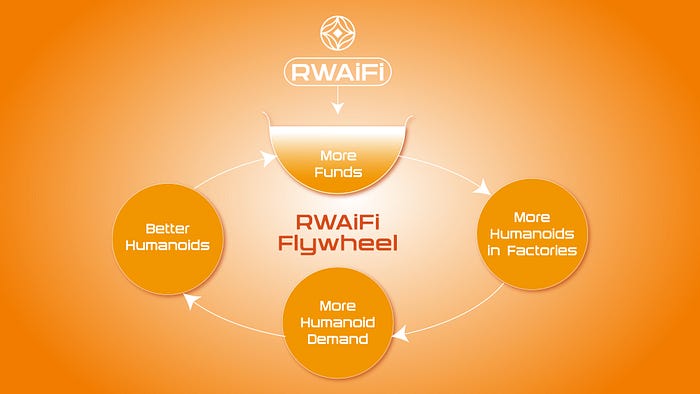OpenMind x GAIB | Unlocking the Future: Why Humanoid Robots Need Blockchain to Break Free and Go Mainstream

If you’ve been keeping an eye on the world of robotics, you know lots of things are heating up fast. We’re talking about AI humanoid robots — those sleek, human-like machines that could soon be folding your laundry, assembling cars, or even chatting with grandma. Buckle up as we break down the market vibes, the big players, and what’s really going on in 2025.
The Current Buzz: Humanoid Robots in 2025 — Market Vibes and Key Players
Right now, in 2025, the humanoid robotics market is valued between $2.9 and $4.3 billion, and experts are projecting it’ll skyrocket to anywhere from $15–76 billion by 2030–2032. We’re looking at growth rates of 39–49% per year, which has even big players like Goldman Sachs revising their forecasts upward by over 500%. Asia Pacific and North America are neck-and-neck, each holding about 40% of the pie, with hardware still ruling the roost at 64–69% of the market share.
Source: IDTechEx, Humanoid Robots 2025–2035
The humanoid robots are also a complicated market, where its complexity can lie somewhere between phones and automobiles. Some players are involved in the supply chain of humanoids, including those that produce the hardwares and components to make the robot itself, while others in the software that gives the robots its intelligence and learning capabilities.
Source: MarketsandMarkets, Humanoid Robot Market
What’s fueling this boom?
A ton of cash, for starters. Nearly $1 billion flooded into humanoid startups every year from 2022–2024 alone. Costs are dropping too — unit prices have fallen 40% in just one year, from $50K-$250K down to $30K-$150K. Tesla’s even aiming for $20K-$30K at scale, making these bots feel less like sci-fi luxury and more like everyday helpers. It’s a global race, with Asia leading in manufacturing muscle and the West innovating on the R&D front.
The competition is fierce, with a mix of ambitious startups, tech giants, and automotive powerhouses all vying for the top spot.
- Tesla: Led by Elon Musk, Tesla’s Optimus is arguably the most famous robot in the race. They’re leveraging their self-driving car AI to build the robot’s brain and plan to use their factory prowess to build thousands of them, targeting 5,000–10,000 units for their own factories in 2025.
- Figure AI: These guys are the current commercial frontrunners. Their Figure 02 robot is already working at a BMW manufacturing plant in South Carolina, performing complex tasks. After a landmark partnership with OpenAI, they are now developing their own proprietary AI –called Helix– to power their robots.
- Boston Dynamics: The OG of advanced robotics, famous for viral videos of their dog-like Spot and athletic Atlas robots. They recently retired their hydraulic Atlas and unveiled a new, stronger, and more agile all-electric Atlas designed specifically for commercial use, with pilot tests starting at Hyundai this year.
- Agility Robotics: They scored a major win with the first commercial humanoid deployment in the U.S. Their robot, Digit, is already working in a Spanx warehouse. Plus, they’ve opened RoboFab, the world’s first mass-production factory for humanoids, capable of building 10,000 robots a year.
- Chinese Competitors: China has emerged as a powerhouse, with companies like Unitree offering their G1 robot for a jaw-dropping $16,000. Meanwhile, UBTech’s Walker S is already on the job in car factories for brands like BYD and Nio. The walker S2 can even change its own battery.
Why Are Most Humanoid Robots Stuck in the Labs?
Robotic demos are everywhere, from the warehouse arm stacking boxes to a humanoid jogging in an obstacle course. Yet, when you step into the real world, you’ll rarely share the sidewalk with a quadruped, or trust some autonomous cleaning bot to tidy your office after hours.
This gap between polished demo (mostly in lab settings) and dependable daily service is what is termed as the reality gap. We have broken down this reality gap into four major technical angles:

The missing ingredient in all these scenarios is related to real-world importance variance. To reiterate, in simulation, every scene is crisp with variables all defined. Robots are thus overfit to these lab sequences and under-represented for edge cases. Weights according to impact of certain edge cases (such as a delivery robot bumping a curb vs blocking a fire exit accidentally) are also missing, both in data and in architecture. Until autonomy models learn from, prioritize, and share the right on-street experiences, robots stay in the lab.
OpenMind is currently building out this shared backbone for robotics through FABRIC, which you can think of as the TCP/IP for machines. Essentially, upon registration of the robots onto this network, signal exchange is prioritized: robots publish embeddings of real-world encounters, and contributors earn for sharing high-value data, steering collection towards the long tail. Entire gig economies can be formed from this knowledge transfer, and as tasks and actions associated with robots are deployed, we will see faster and exponential iteration of robotics in the real world. Leveraging this composability, third-party devs can build skills atop a common backbone, while a proof-of-location mechanism ensures regulators and end-users trust each other in this shared layer.
Blockchain to the Rescue: Smarter Deployment, Ironclad Safety, and Lightning-Fast Funding
Leveling Up Deployment
From a high level, blockchain gives robotics something the field has always lacked: a shared, tamper-proof coordination layer that spans capital, control, and data — essential pillars for their deployment into the real world. By turning each robot (or the work it produces) into an onchain asset, investors can supply cap-ex up front, operators can stream usage payments or maintenance proof in real time, and autonomy engineers can audit failure cases without barriers.
Possibilities remain endless. So far, the tokenization of machine RWAs has already started moving from pilot to production. Delivery drones and warehouse arms are being fractionalized so the general public can co-own a revenue-generating fleet. The same rails can also handle micro-payments between machines, making it economical for a robot to engage in transactions themselves (e.g. data, LiDAR patches, spatial awareness tiles), which are core use cases in DePIN that the blockchain community sees true utility in.
On an even more fundamental level, we believe that blockchain unlocks an element of transparency and trust that lets real-world performance flow directly into open markets. Proofs of action become collateral for forward deployment, operator-as-a-service bounties, and even financing for the robots themselves. Without this verifiable, shared source of truth, coordination between operators and machines collapse under opaque data and conflicting incentives. Blockchain creates a foundation where every stakeholder, human or machine, can operate with confidence. In this sense, trust is not just a byproduct of the technology, it is the bedrock for future robotic collaboration and economies.
Building Trust: Verifiability
With trust, we need verifiability so that any associated action can be linked to a given identity and rendered safe. Again, OpenMind’s FABRIC sits at the heart of the stack. Each device carries a cryptographic identity and registration layer that notarizes three things that capital markets and engineers both care about: robots (and the humans around them) prove where they are, what they’re doing, and who they’re working with (e.g., who maintained or tele-operated it last). These translate into proof-of-location, proof-of-workload, and proof-of-custody, respectively. By anchoring every machine’s actions to a verified digital passport, FABRIC allows usage logs, permissions, and rewards to be transparently tied to individual robots. These attestations flow into a public ledger, aligning incentives across utilization, downtime, and cashflow with verifiable data.
Verifiability then unlocks a myriad of future opportunities for model and application development on top of a unified layer. For one, we have accelerated robotic learning capabilities by means of forward deployment and learning linked to robotic identity. When robots are first deployed, they rely on teleoperators to navigate dynamic, multivariable environments. FABRIC captures these sessions as structured, high-value data (both in terms of interaction data and labeled edge-case scenarios). As this dataset grows, FABRIC continuously improves autonomy across the fleet, reducing reliance on human intervention over time. This creates a positive feedback loop where early teleops generate the data fuel that accelerates learning, while stakers and operators earn rewards proportional to the quality and novelty of the collected data. To ensure that this data is relevant, association to a registered identity is again mission-critical.
The next step past knowledge development is related to verifiable actions. Once we reach a level where knowledge sharing is sufficient, we then start to think about its subsequent distribution and applications. In a way, we predict that robots are set to function as autonomous workers in a machine-powered gig economy. Operator-as-a-service bounties let skilled teleoperators complete tasks or interventions on-demand, while robots themselves can “bid” for micro-jobs (e.g., from mapping an environment to streaming sensor data) and receive instant, on-chain payments. By combining this with forward deployment, all linked in a shared identity, we create a hybrid workforce where humans, machines, and investors are safely aligned around an expected performance and output.
Speeding Up the Game
Let’s shift gears and talk about the accelerator pedal here — financing. If you’ve ever wondered why humanoid robots aren’t flooding factories and homes yet, a big part of it boils down to money. Developing, building, and deploying these bots is insanely expensive: We’re talking millions in R&D, plus those $30K-$150K per-unit costs that, while dropping, still add up fast for any factory or business looking to scale. Traditional funding? It’s slow, centralized, and often locked behind venture capital gates or bank loans that come with strings attached.
Enter RWAiFi (RWA + AI + DeFi), turbocharging this whole scene by making robot ownership accessible, liquid, and downright profitable for everyday folks like you and me.
At its core, this is about Real World Assets (RWA) meeting DeFi that accelerates the AI industry. Imagine tokenizing an AI-powered humanoid robot — turning it into a digital asset on the blockchain. Instead of one company footing the entire bill, you could co-own a piece of that robot through tokens.
Here’s a real-world example:
Picture a factory deploying a fleet of Optimus or Figure bots to streamline their production line, cranking out cars or gadgets 24/7. That robot generates actual value — increased output, cost savings, you name it. With blockchain, we can put that robot’s ownership “onchain” as a token. Investors (yep, that could be you) buy in, and in return, you claim a slice of the yields — think dividends from the factory’s boosted efficiency or even direct revenue shares.
This isn’t just pie-in-the-sky stuff; it’s creating a positive flywheel that could catapult humanoids into the mainstream.
How? For example:
Factories — get the capital to buy and deploy more bots without drowning in debt, scaling their operations overnight. Robot developers and issuers — They’re incentivized to crank out smarter, more capable robots to meet the surging demand; better AI, longer battery life, you get it. And as these bots prove their worth, their value skyrockets, pulling in more investors hungry for those real-world yields. More investment means more innovation, more adoption, and round and round we go. It’s like Kickstarter on steroids, but with actual economic loops that benefit everyone.

And here’s where GAIB steps in to make this magic happen. We’re all about RWAiFi.
As the economic layer powering the AI industry, we specialize in financing AI industry like compute assets, and probably humanoids assets soon. 😉
We can imagine, factories can tap into our ecosystem to fund their robot fleets, while users stake our AID (our AI synthetic dollar, a multichain yield-bearing asset) to get in on the action. Stake AID, and you’re essentially backing these robots, earning yields from the real value they generate — whether it’s a bot assembling EVs in a Chinese factory or handling logistics in a U.S. warehouse. It’s seamless, borderless, and way faster than waiting on traditional banks. And most importantly, stakers are backed by the growth of the whole AI and robotics industry. I.e. You are riding the future.
DeFi takes this to the next level with its superpowers: Liquidity pools, automated lending, and yield farming mean you can borrow against your robot tokens, trade them instantly on DEXes, or even use them as collateral for other investments. Need quick cash to expand your bot fleet? DeFi protocols can provide loans backed by onchain assets in just a few clicks. This slashes barriers for startups and factories, speeding up adoption like never before. Plus, it’s transparent — every transaction is verifiable on the blockchain, building trust and attracting even more capital. At GAIB, we’re building tools to make this flywheel spin effortlessly, turning AI dreams into funded realities.
About GAIB
GAIB is the first economic layer for AI and compute, transforming GPU-backed assets into yield-generating opportunities. Through AID, GAIB’s AI synthetic dollar, investors can seamlessly access the AI economy while earning real yield from AI-powered compute. Staking AID (sAID) allows token holders to earn rewards while maintaining liquidity, offering access to AI-driven financial markets.
GAIB also powers AI infrastructure by providing capital solutions for cloud providers and data centers, optimizing their access to compute resources. With integrations across DeFi protocols, including lending, borrowing, and structured products, GAIB bridges AI and blockchain finance, unlocking new opportunities at the intersection of technology and investment.
Website | X | GAIB Fremen | Telegram |Discord | Docs
About OpenMind
OpenMind is building the universal operating system for intelligent machines. Its OM1 platform enables robots of all forms to perceive, adapt, and act in human environments. FABRIC, its decentralized coordination layer, creates secure machine identity and powers a global network where intelligent systems collaborate. Together, they lay the foundation for machines that can operate across any environment while maintaining security and coordination at scale. OpenMind is based in San Francisco, and encourages you to learn more at www.openmind.org.

